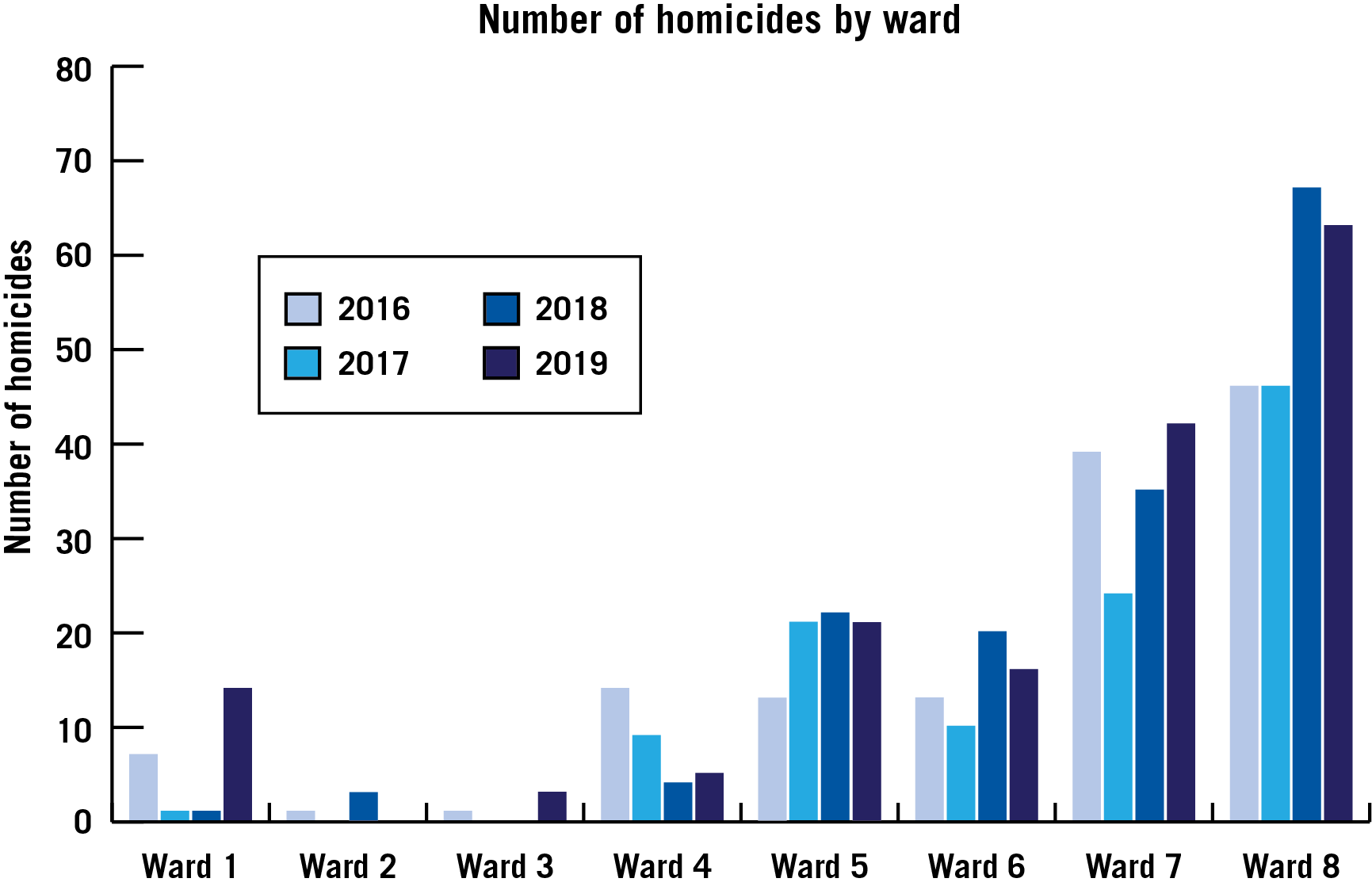Despite a city-wide uptick in murders, the area on and around campus was unaffected by homicides in 2019, Metropolitan Police Department data shows.
Ward 2 – which encompasses the Foggy Bottom Campus and much of downtown D.C. – logged zero homicides in 2019, but the counts fluctuated in other areas of the city, from three killings in Ward 3 to 63 in Ward 8. Criminal justice experts said Ward 2’s low homicide numbers are likely a reflection of the area’s low poverty rate, which can correlate with violence, compared to relatively more impoverished city sectors.
MPD spokeswoman Alaina Gertz said the department does not comment on crime trends, but many homicide victims and suspects carry illegal firearms and have prior violent offenses.
About 80 percent of the year’s homicides were committed with a gun, about 18 percent were committed with a knife and the rest were committed with various other weapons, according to District data.
Gertz said MPD plans to work with District organizations like the Pathways for Young Adults program, which assists young unemployed people who are not in school to find job training and work. She said the department will also work with the Office of Neighborhood and Safety Engagement office, which works with other agencies to lower the city’s violence rates.
“The city is working to address those root causes by engaging individuals who have fallen into that high-risk group through interventions,” Gertz said in an email.

Alyssa Illaria | Graphics Editor
MPD data shows 166 documented homicides throughout D.C. last year, the deadliest year the District faced in more than a decade. Seven homicides have been committed so far this year – none of which occurred in Ward 2 – compared with eight at this time last year, according to MPD’s crime map.
The majority of the District’s homicides are concentrated in Wards 7 and 8, according to MPD data. Gertz said MPD plans to implement violence prevention programs this year, like summer and fall crime prevention initiatives, that target homicide-prone areas of the city.
“MPD will continue to work hard to prevent and deter all crime throughout the entire city in the upcoming year,” Gertz said.
Criminal justice experts said high poverty rates correlate with homicide rates because people who live in poverty are more likely to feel isolated from their communities and turn to violence.
Ward 2, which has consistently maintained some of the city’s lowest homicide rates, experienced a slight downturn in homicides in 2019 – from three to zero – which David Brotherton, a professor of sociology and criminology at the City University of New York, said is likely connected to Ward 2’s high education and employment levels.
Ward 2 has a 3 percent unemployment rate, compared with 7 percent District-wide, according to D.C. Health Matters data. Thirty percent of Ward 2’s population over the age of 25 holds at least a bachelor’s degree, and about 29 percent hold a master’s degree, compared with 24 and 20 percent city-wide.
“When you have levels of one, two and three, marginal differences, you can’t really say much,” Brotherton said.
He added that areas with more thorough policing are less likely to experience high homicide rates because police officers are present to prevent violent crimes from occurring. Poverty doesn’t directly cause spikes in homicide rates but leads to an environment in which people are more likely to commit interpersonal violence, Brotherton said.
He said poverty can lead to high rates of stress and mental illness, which can cause people to turn to violence and interpersonal crimes.
“In those circumstances, violence can come out simply from frustrations and alienation,” Brotherton said.
Ward 2 boasts the second-highest median income in the city, about $105,000 compared to the rest of D.C., according to data from D.C. Health Matters. Wards 7 and 8 have the lowest median incomes, rounding out to about $38,000 and $34,000, respectively.
“We know that poverty creates all kinds of full conditions in which people have to make their lives every day,” Brotherton said. “Poverty makes it difficult for families to function properly. There’s a lot of trauma within families, crises within families just caused by the need to survive.”
John Michaud, the director of Husson University’s School of Legal Studies in Maine, said examining the types of homicide, like domestic disturbances or violent felonies, allows police officers to develop strategies to target the specific causes of killings.
“It’s important when you look at homicides not to look at them as a total picture, but more as pixels that put the total picture together,” Michaud said. “And then you can look for causes.”
He said factors like Ward 2’s demographics and the presence of universities, which are equipped with their own police departments that provide additional crime prevention, could contribute to an area’s low homicide rate.
Michaud said police departments can use methods like crime mapping to determine which areas of the city have the highest concentration of homicides and target those areas.
“People have to understand that there are only X number of police officers, only X number of dollars to spend,” Michaud said. “So are there areas that the police department, that law enforcement can recognize as high concentrations of crime areas? Obviously, that’s where they need to put their resources.”





